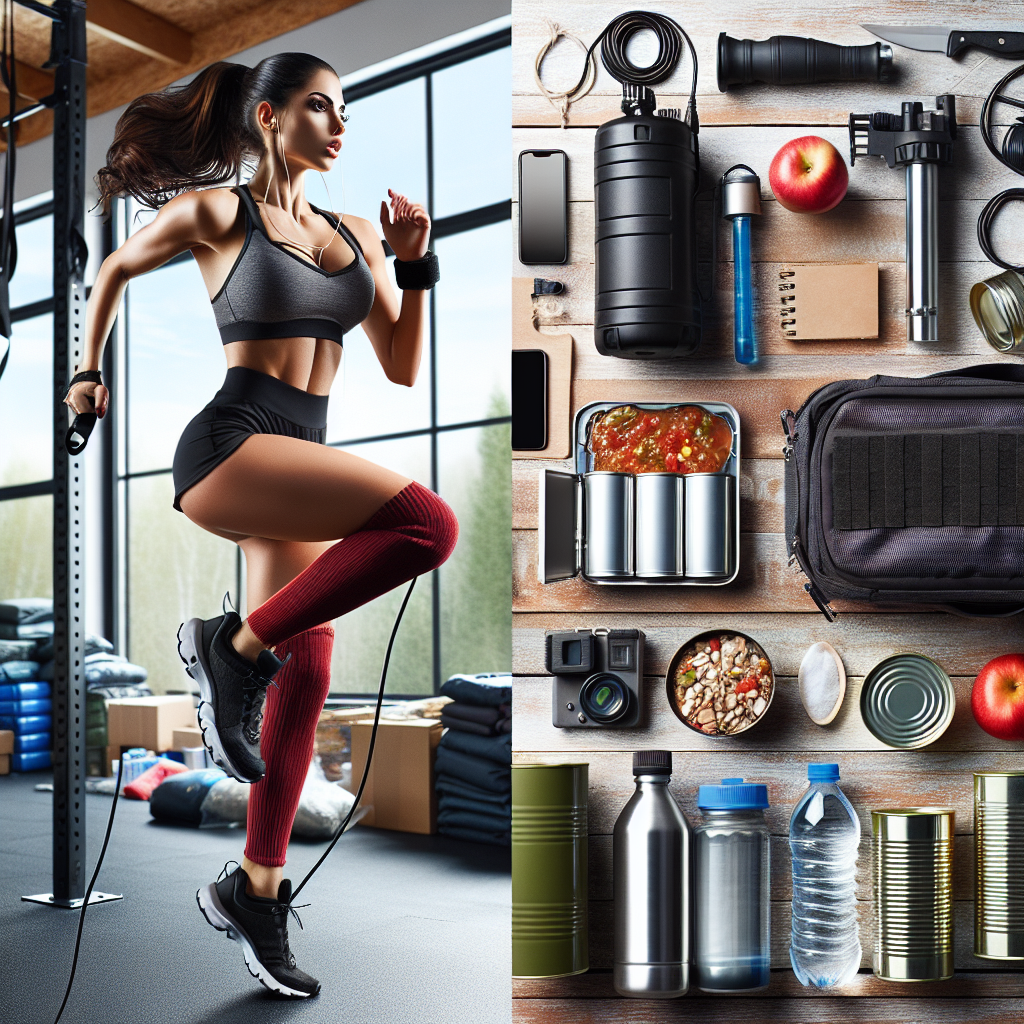Womens Preparedness
Female-Focused Emergency Preparedness: How to Safeguard Women in Times of Societal Collapse

Hello ladies, my name is Jade Tripp and I am here to discuss the importance of female-focused emergency preparedness. In times of societal collapse, women can often find themselves in vulnerable situations, facing unique challenges that require specific strategies for self-protection and survival. It is crucial for us to be proactive and prepared in order to safeguard ourselves and our loved ones.
One of the first steps in female-focused emergency preparedness is to create a comprehensive emergency plan. This plan should include detailed instructions on what to do in various scenarios, such as natural disasters, civil unrest, or economic collapse. Make sure to consider the specific needs of women, such as access to feminine hygiene products, medications, and childcare provisions. It is also important to establish a communication plan with your family and friends, so that you can stay connected in case of an emergency.
In addition to having a solid emergency plan, women should also prioritize physical self-defense and personal protection. Taking self-defense classes can be incredibly empowering and give you the skills and confidence to protect yourself in dangerous situations. Remember, it is always better to be prepared and never need to use these skills, rather than finding yourself in a dangerous situation without any means of self-defense.
Another important aspect of female-focused emergency preparedness is having a well-stocked emergency kit. This kit should include items such as non-perishable food, water, first aid supplies, flashlights, batteries, and personal hygiene products. It is also a good idea to pack a self-defense tool, such as pepper spray or a whistle, in case you need to protect yourself from an attacker.
It is also important to consider the security of your home and surroundings. Make sure your home is secure with sturdy locks, alarm systems, and security cameras. You may also want to consider joining or forming a neighborhood watch group to increase safety in your community.
Remember, being prepared is not about living in fear, but about being proactive and taking control of your own safety and well-being. By prioritizing female-focused emergency preparedness, you can safeguard yourself and your loved ones in times of societal collapse. Stay safe, stay prepared, and empower yourself to face any challenges that may come your way.
Womens Preparedness
Breaking Barriers: Women Redefining Off-Grid Living in a Male-Dominated Field

Hello, fellow women adventurers! I’m Jade Tripp, and I’m excited to dive into a topic that inspires me deeply: women redefining off-grid living in a realm that’s often viewed as male-dominated. If you’ve ever dreamed of living a life that embraces self-sufficiency, connection with nature, and independence, you’re not alone! Women from all walks of life are paving their own paths, proving that the power of femininity can thrive in the great outdoors.
The Rise of Women in Off-Grid Living
When we think of off-grid living, many may picture rugged men working manually to establish a self-sustaining homestead. However, the landscape is changing! Women are stepping forward to redefine what off-grid living looks like, embracing a holistic approach that beautifully combines practical skills with creativity and compassion.
Real-Life Trailblazers
Let’s look at some inspiring women who are making waves in the off-grid community.
-
Julia "Jules" Moskin: Jules is an author and homesteader who transitioned from a busy urban life to living off-grid in Northern California. Through her blog, "Jules Off Grid," she shares her journey of self-discovery and learning to plant, harvest, and preserve food. Jules emphasizes the importance of community, inviting other women to join her workshops. Her story reminds us that by sharing knowledge and skills, we empower one another.
-
Kristen and Dave: This dynamic couple decided to build their tiny home on wheels and travel across America, embracing the freedom of off-grid living. Kristen frequently speaks at women’s workshops, focusing on DIY skills and home maintenance. Her approach breaks the stereotype that off-grid living is only for those with years of experience—she advocates for the idea that you can start at any stage!
- Nicole Apelian: A survivalist and herbalist who transitioned from the corporate world to a rustic lifestyle, Nicole has participated in several survival shows, proving that women can thrive in challenging situations. She focuses on using natural resources wisely, empowering women to learn survival skills that can enhance their confidence and preparedness.
Skills and Mindsets for Off-Grid Living
Living off-grid isn’t just about a change in location; it’s a mindset. Here are some key areas where women can equip themselves with practical skills to thrive in these settings:
1. Self-Defense and Personal Safety
Whether you’re hiking in remote locations or setting up your homestead, personal safety should always be a priority. Learning essential self-defense techniques is a fantastic way to feel empowered.
- Enroll in Self-Defense Classes: Look for local classes or workshops. Many programs focus specifically on self-defense for women, equipping you with the skills and confidence you need to navigate isolated environments.
- Practice Situational Awareness: Always be aware of your surroundings. It helps to develop instincts that keep you safe in both urban and rural settings.
2. Emergency Preparedness
Being off-grid means being prepared for various situations. Here are some tips to ensure you’re ready:
- Create an Emergency Kit: Include first-aid supplies, non-perishable food, water, and fire-starting tools. Ensure you have communication methods like a whistle or a signal mirror.
- Learn Survival Skills: Basics like building a shelter, starting a fire, or foraging are crucial. There are plenty of online courses and community workshops that can teach you these vital skills.
3. Gardening and Sustainable Practices
Having a green thumb can save you money and ensure you’re eating healthy foods.
- Start Small: Choose a few easy-to-grow vegetables or herbs and expand as you gain confidence. Indoor gardening is also a wonderful way to get started!
- Join a Local Gardening Club: Surrounding yourself with experienced gardeners can provide invaluable tips and foster friendships with like-minded women.
Building Community
One of the most enriching aspects of off-grid living is the sense of community you can build. Whether it’s forming local groups focused on self-sustainability, hosting workshops, or even connecting online, there’s immense power in sharing knowledge and resources.
1. Networking Events and Workshops
Seek out events focused on off-grid living and self-sufficiency. Many women are eager to share their experiences and techniques.
2. Online Forums and Social Media
Join groups that align with your interests in off-grid living. These platforms are fabulous for asking questions and sharing experiences.
Conclusion: Embracing Your Journey
As women, we have an amazing opportunity to challenge the traditional narratives surrounding off-grid living. Your journey can be a beautiful expression of independence, creativity, and resilience. Whether you want to develop skills for self-defense, become proficient in gardening, or connect with fellow off-grid enthusiasts, the possibilities are endless.
Remember, it’s not about fitting into a mold but rather carving your path and redefining what it means to live off-grid. So, take that leap into the wild and know that you are not alone. Together, we can break barriers and inspire each other on this incredible journey of self-discovery and empowerment.
Let’s embrace our strength, creativity, and sisterhood in the exciting world of off-grid living! 🌿✨
Womens Preparedness
From Cardio to Canned Goods: How Prepping and Fitness Go Hand in Hand for Women

From Cardio to Canned Goods: How Prepping and Fitness Go Hand in Hand for Women
Hello, everyone! I’m Jade Tripp, and I’m so excited to connect with you today. As women, we face unique challenges in both our daily lives and in our journey toward self-reliance and preparedness. You may not think about it often, but your physical fitness and your prepping strategies can complement each other in powerful ways. Together, let’s explore how cardio routines can boost your prepping game, why nutrition is essential, and how you can incorporate practical fitness exercises into your prep plan.
The Vital Connection Between Fitness and Prepping
Prepping isn’t just about stockpiling food and essentials; it’s about building the resilience we’ll need in unforeseen situations. This resilience often extends beyond our physical stamina; it’s about mental readiness, and being fit can help.
But what does cardio have to do with canned goods? Let’s break it down!
1. Physical Conditioning: Are You Ready to Fend for Yourself?
Imagine this scenario: a natural disaster strikes, and you need to evacuate your home quickly. If you’re physically fit, you’ll find yourself at a significant advantage. Cardio exercises enhance your cardiovascular health and stamina, enabling you to move quickly and effectively.
Real-Life Example:
In 2018, when Hurricane Florence hit North Carolina, many women found themselves in evacuation zones. Those who regularly incorporated cardio workouts into their routines reported feeling more capable handling the stress and physical demands of evacuating. They could carry essential supplies or help their neighbors, an essential part of community resilience.
2. Mental Toughness: Building Your Resilience
Physical fitness plays a critical role in building mental toughness. Engaging in regular cardio can elevate your mood and confidence, making you more adept at handling stressful situations.
Personal Anecdote:
When I was training for a 10k run, I found that my mental barriers crumbled with each mile I put in. This experience taught me that the determination I cultivated on the running trail directly translated to my daily life, including my preparedness planning. I began tackling my prepping to-do list with the same energy and mindset.
3. Nutrition: Fueling Your Fitness and Preparedness
While we prep our homes with canned goods, it’s equally essential to ensure our bodies are fueled properly. Balanced nutrition enhances your fitness efforts, allowing you to maintain the energy levels needed for both physical activity and emergency situations.
Practical Tips:
- Stock Up Wisely: When building your food supply, consider nutrient-dense foods. Canned beans, vegetables, and fruits are not only convenient but also provide essential vitamins and minerals.
- Plan Meals: Practice meal prepping with your stockpile. During your weekly grocery run, make a point to prepare recipes that integrate your canned goods!
4. The Power of Community: Encouragement and Support
Having a tribe is crucial in both fitness and prepping. Together, we can motivate one another, share tips, and build connections that go beyond our individual goals.
Example from My Community:
I’ve been lucky enough to be part of a local women’s self-defense and fitness group. We share not only workouts but also strategies for prepping as a community, from collective buying groups for canned goods to hosting workshops on food preservation and self-defense techniques. It’s empowering to support each other on this journey.
5. Movement in the Midst of Emergency: Training for the Unexpected
In addition to cardio and nutrition, you should consider incorporating functional fitness elements into your prep routine. Think about exercises that mimic movement you might find yourself doing in a crisis—lifting, carrying, or sprinting.
Simple Exercises to Get You Started:
- Squats: Mimic lifting heavy objects. Add a backpack filled with weight to simulate what you might carry in a real situation.
- Burpees: Excellent for building overall strength and can be done anywhere.
- Interval Running: Simulate the need for speed during emergencies, with quick bursts of running followed by walking or jogging.
Rekindling Your Inner Strength
Ladies, I encourage each of you to embrace the synergy of fitness and preparedness. While it can seem overwhelming at times, remember that every small step counts. Start with simple cardio workouts and gradually incorporate nutrition-focused prepping into your life. As you build your physical strength, you’ll also reinforce your mental resilience.
Conclusion: Empowered Women, United Goals
As women, we can be incredible forces when united. By supporting one another in our fitness and prepping journeys, we set ourselves up for survival—both in everyday life and in emergencies. So lace up those shoes, gather your canned goods, and join me in preparing for whatever life throws our way.
Stay strong, stay prepared, and remember—the best version of yourself is always within reach!
With love and encouragement,
Jade Tripp ✨
Womens Preparedness
BIRTH PREPAREDNESS HRP

Film on Birth Preparation (HRP) talks about educating pregnant women on appropriate facility delivery in case of high-risk …
source
-

 Womens Self Defense11 months ago
Womens Self Defense11 months agoNew Legislation Empowers Women to Defend Themselves
-

 Self Defense News1 year ago
Self Defense News1 year agoShe was convicted of killing her abusive boyfriend. Now a Maple Grove woman is home awaiting a new trial.
-

 Self Defense News1 year ago
Self Defense News1 year agoSelf-Defense for All: The new Gracie Jiu-Jitsu Pasadena is for everyone | Online Features
-

 Womens Self Defense8 months ago
Womens Self Defense8 months agoUnderstanding State-by-State Variation in Self Defense Laws
-

 Womens Self Defense1 year ago
Womens Self Defense1 year agoTop 5 Self-Defense Techniques Every Woman Should Know
-

 Womens Fitness1 year ago
Womens Fitness1 year agoXtreme Bodyweight HIIT (Lots of Jumping!) | Joanna Soh (Fio Series)
-

 Womens Preparedness1 year ago
Womens Preparedness1 year agoEmpower Yourself: A Guide to Female Survival Planning
-

 Womens Preparedness1 year ago
Womens Preparedness1 year ago10 essential skills for surviving in the great outdoors



